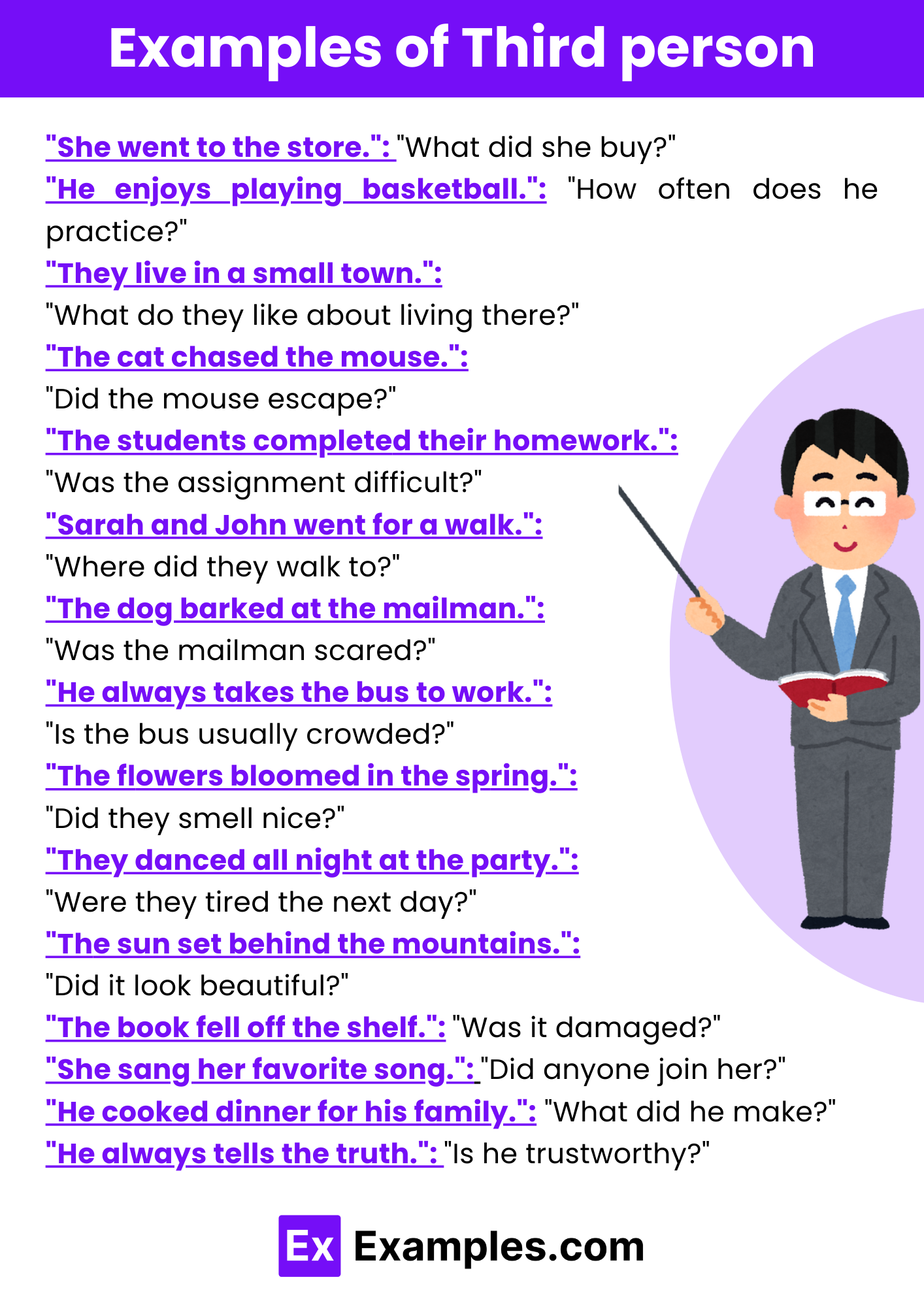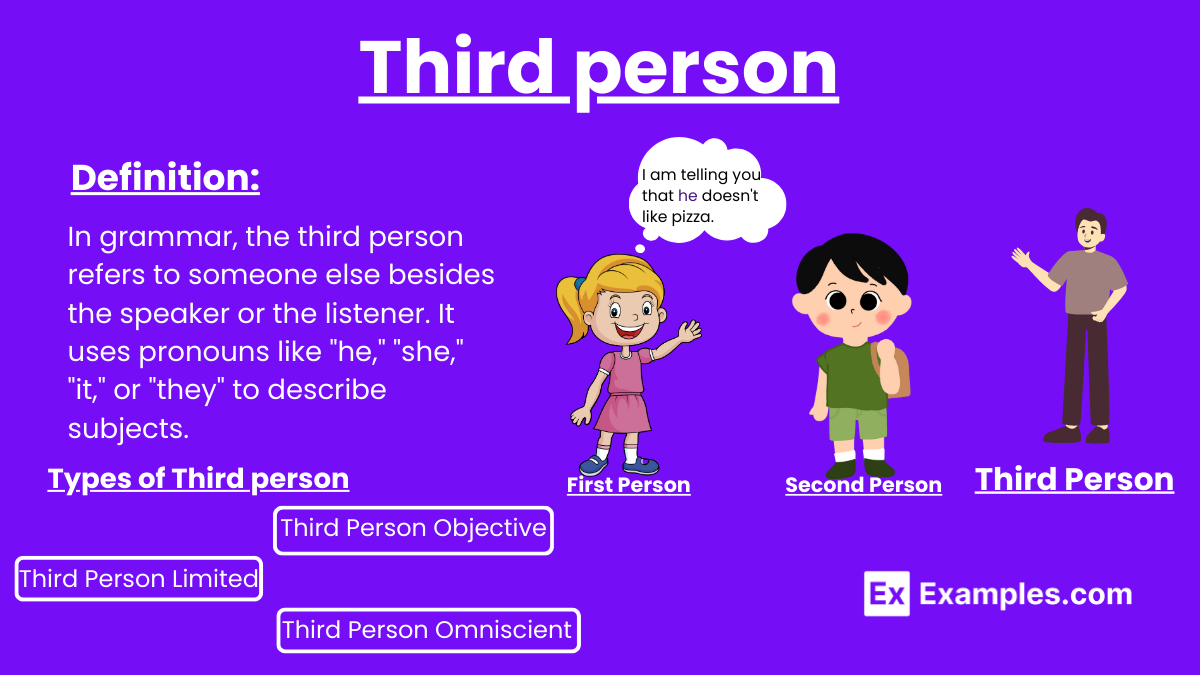40+ Third person Examples
In third-person narrative text, the story is narrated using pronouns like “he,” “she,” or “they.” This perspective provides a more detached viewpoint, allowing the author to describe events and characters’ thoughts without direct involvement in the action.
What is Third person?
In third-person narration, there are various levels of knowledge and intimacy that the narrator can have with the characters’ inner thoughts and feelings. For instance, Third-Person Effect Theory in Mass Communication stays closely aligned with one character’s perspective, revealing their thoughts and emotions directly to the reader, often as if hearing their internal speech. Verb forms contrast, third-person omniscient narration provides a god-like insight into all characters and events, allowing the narrator to offer commentary and insight that goes beyond any single character’s perspective.
30 Third person Examples with Answers

- “She went to the store.”: “What did she buy?”
- “He enjoys playing basketball.”: “How often does he practice?”
- “They live in a small town.”: “What do they like about living there?”
- “The cat chased the mouse.”: “Did the mouse escape?”
- “The students completed their homework.”: “Was the assignment difficult?”
- “Sarah and John went for a walk.”: “Where did they walk to?”
- “The dog barked at the mailman.”: “Was the mailman scared?”
- “He always takes the bus to work.”: “Is the bus usually crowded?”
- “The flowers bloomed in the spring.”: “Did they smell nice?”
- “They danced all night at the party.”: “Were they tired the next day?”
- “The sun set behind the mountains.”: “Did it look beautiful?”
- “The book fell off the shelf.”: “Was it damaged?”
- “She sang her favorite song.”: “Did anyone join her?”
- “He cooked dinner for his family.”: “What did he make?”
- “The baby slept soundly through the night.”: “Did the parents sleep well too?”
- “They visited the museum on Saturday.”: “Which exhibit did they like the most?”
- “The rain stopped just in time for the picnic.”: “Did they have a good time?”
- “He studied for his exam all week.”: “Did he pass?”
- “The birds chirped happily in the trees.”: “Did they fly away?”
- “She won first place in the race.”: “Was she surprised?”
- “They watched a movie together.”: “What genre was the movie?”
- “The train arrived at the station on time.”: “Did they catch it?”
- “He always tells the truth.”: “Is he trustworthy?”
- “She laughed at his joke.”: “Was it funny?”
- “They bought a new car last month.”: “What color is it?”
- “The wind blew the leaves off the trees.”: “Did it make a mess?”
- “He greeted his neighbors with a smile.”: “Were they friendly?”
- “She wrote a letter to her friend.”: “Did she receive a reply?”
- “They hiked to the top of the mountain.”: “Was the view worth it?”
- “The cat curled up by the fireplace.”: “Was it warm?”
Third person Sentence Example
- “He carefully examined the ancient artifact, marveling at its intricate design.”
- “She glanced nervously at her watch, realizing she was running late for the meeting.”
- “They gathered around the campfire, exchanging stories under the starry sky.”
- “The cat lazily stretched out in the sunshine, enjoying the warmth of the afternoon.”
- “The old oak tree stood tall and proud in the center of the meadow, its branches swaying gently in the breeze.”
Third person Words Examples
- He: “He went to the store to buy groceries.”
- She: “She loves to read books in her spare time.”
- They: “They are planning a trip to Europe next summer.”
- It: “The cat chased the mouse, but it escaped through a small hole.”
- His: “John forgot to bring his umbrella, so he got soaked in the rain.”
Third person essay Examples
- “In modern society, individuals are often faced with the challenge of balancing work and personal life.”
- “One of the key factors contributing to climate change is the excessive emission of greenhouse gases.”
- “Research has shown that regular exercise is associated with numerous health benefits, including reduced risk of chronic diseases.”
- “It is widely acknowledged that education plays a crucial role in shaping the future of society by empowering individuals and fostering economic growth.”
- “The novel explores themes of identity and belonging through the journey of its protagonist as she navigates the complexities of adolescence.”
Third person writing Examples
- “Sarah walked down the street, lost in thought as she pondered her next move.”
- “James gazed out the window, watching the raindrops patter against the glass.”
- “The students eagerly listened as the teacher explained the principles of mathematics.”
- “The politician delivered a passionate speech, rallying support from the crowd gathered in the town square.”
- “The scientist conducted experiments in the lab, carefully recording each observation in her notebook.”
Synonym for Third person
| Term | Synonym |
|---|---|
| Third person | He/she/they perspective |
| Third-person point | Outsider’s view |
| Third-person | Objective viewpoint |
Third Person Grammar
“Third person” in grammar refers to a perspective where the speaker or writer refers to someone or something other than themselves (the first person) or the person(s) being addressed (the second person). In third person, pronouns such as “he,” “she,” “it,” or “they” are commonly used to refer to people or things. This perspective provides a more objective view compared to first or second person.
Third person writing
Third person writing refers to a narrative style where the narrator or author uses pronouns like “he,” “she,” “it,” or “they” to refer to characters or entities in the story. This perspective offers a more detached and objective viewpoint compared to first person (“I,” “we”) or second person (“you”) writing. It is commonly used in fiction, academic writing, and formal essays to maintain a sense of neutrality and professionalism.
Third Person Pronouns
| Subject Pronouns | Object Pronouns | Possessive Adjectives | Possessive Pronouns | Reflexive Pronouns |
|---|---|---|---|---|
| he | him | his | his | himself |
| she | her | her | hers | herself |
| it | it | its | its | itself |
| they | them | their | theirs | themselves |
Third person Point of view
Introduction: Begin by introducing the speaker in the third person, using their name or title. For example: “John Smith is a seasoned entrepreneur with over two decades of experience in the industry.”
Background Information: Provide some background information about the speaker or the topic of the speech, still maintaining the third person perspective. For instance: “Throughout his career, John has demonstrated a passion for innovation and leadership.”
Statement of Purpose: Clearly state the purpose or main objective of the speech from the third person perspective. For example: “Today, John will share his insights on effective leadership strategies in a rapidly evolving business landscape.”
Engaging Hook: Use a compelling hook to capture the audience’s attention and draw them into the speech. This could be a question, anecdote, statistic, or quote. For instance: “Imagine a world where every leader empowers their team to achieve greatness. This is the vision that John will explore today.”
Transition to First Person: After the initial introduction and hook, transition into the first person point of view if the speech calls for it. This is where the speaker directly addresses the audience and begins to deliver the main content of the speech.
Types of Third person
Third Person Limited: The narrative is told from the perspective of a single character. The reader sees events through this character’s eyes and only knows their thoughts and feelings. Pronouns like “he,” “she,” and “they” are used. Example: “She walked through the forest, feeling a sense of unease.”
Third Person Omniscient: The narrator knows and can reveal the thoughts, feelings, and experiences of all characters in the story. Pronouns like “he,” “she,” and “they” are still used, but the narrator can provide insight into multiple characters. Example: “He glanced nervously at her, unaware of the surprise she had planned for him.”
Third Person Objective: The narrative is told from an outside perspective, where the narrator does not reveal any character’s thoughts or feelings. Instead, the narrator only describes what can be observed externally. Pronouns like “he,” “she,” and “they” are used, but there is no insight into the characters’ internal states. Example: “She ran down the street, her hair flying in the wind.”
The Difference between Third person and Second person
| Aspect | Third Person Perspective | Second Person Perspective |
|---|---|---|
| Definition | Narrator refers to characters by name or pronouns (he, she, they). | Narrator directly addresses the reader as “you.” |
| Pronouns | Uses pronouns like “he,” “she,” “they,” or character names. | Uses the pronoun “you” to address the reader directly. |
| Narrative Distance | Offers a more distant perspective from characters, providing observations and insights from an external viewpoint. | Creates a closer narrative distance by directly involving the reader in the story. |
| Reader Engagement | Provides a sense of observation rather than direct involvement, allowing readers to view events from an outsider’s perspective. | Engages readers by directly addressing them and making them active participants in the narrative. |
| Common Usage | Commonly used in fiction writing, where the narrator is separate from the characters. | Less common in narrative writing but frequently used in instructional texts, interactive fiction, and certain literary genres. |
| Example Sentence | “She walked down the street, lost in thought.” | “You walk down the street, taking in the sights and sounds around you.” |
Tips for Writing in the Third Person
- Maintain Consistency
- Establish Clear Perspective
- Develop Characters
- Create Distance
- Show, Don’t Tell
- Use Descriptive Language
- Avoid Omniscience
What is third person perspective in writing?
Third person perspective is a narrative mode where the story is told by an external narrator who refers to characters using pronouns like “he,” “she,” or “they,” rather than “I” (first person) or “you” (second person).
How do I avoid head-hopping in third person perspective?
Stick to one character’s perspective per scene or chapter to avoid confusing your readers. Transition between characters’ viewpoints using clear scene breaks or chapter divisions.
Can I use first person pronouns in third person perspective?
No, third person perspective uses pronouns like “he,” “she,” “they,” or character names to refer to characters. Avoid using “I” or “you” in third person narration.
How do I maintain consistency in third person perspective?
Use consistent pronouns or character names throughout your narrative. Ensure that your descriptions, dialogue, and character actions remain consistent with the chosen perspective.
Can I write dialogue in third person perspective?
Yes, dialogue can be written in third person perspective. Use quotation marks to indicate spoken words, and attribute dialogue to specific characters using dialogue tags.
How do I maintain consistency in third person perspective?
Use consistent pronouns or character names and ensure descriptions, dialogue, and actions align with the chosen perspective.
What are the advantages of third person perspective?
Offers flexibility, broader storytelling scope, and maintains objectivity.
How do I avoid head-hopping in third person perspective?
Stick to one character per scene or chapter, transitioning with clear breaks.
Are there specific genres suited to third person perspective?
Commonly used in fiction, fantasy, mystery, and romance, but adaptable to most genres.
How do I provide insight into characters’ thoughts and emotions?
Show indirectly through actions, dialogue, and body language, avoiding direct statements in limited third person.



